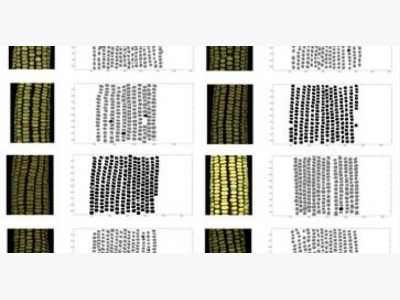New method analyzes corn kernel characteristics

Kernel maps of all maize ears. If no multi-counts occurred, the kernels are shown in black. In case of multi-counts, the kernels are shown in grey, and the multi-counted kernels in black.
New imaging machine helps corn breeders learn number of kernels per ear, plus much more information than can be observed manually.
An ear of corn averages about 800 kernels. A traditional field method to estimate the number of kernels on the ear is to manually count the number of rows and multiply by the number of kernels in one length of the ear. With the help of a new imaging machine developed at the University of Illinois, corn breeders can learn the number of kernels per ear, plus a lot more information than can be manually observed.
“If you take that same ear of corn into a lab, you can take the same approach but use an imaging system to get a more accurate measure of the total number of kernels,” said Tony Grift, lead scientist on the project. “You can go a lot further than that. By pinning the ear on a spike and turning it automatically, we can present each row individually to a camera. This allows us to determine up to 16 morphological characteristics of each kernel, including kernel area, circumference and circularity, a measure for how close the kernel shape is to a circle. We can also calculate the center of gravity and the location of the kernel on the ear; in fact, we use these to make sure we don’t count kernels more than once.”
The imaging machine itself isn’t fancy. It’s more like a tabletop photography studio. A single halogen light is hung outside, above the box. The box itself is made from high-density polyethylene (HDPE), which is typically used to make cutting boards.
Grift said the key is in the lighting. “Having a good camera is one thing, but light is very important. Light has to come from everywhere, so we channel light from the halogen bulb through a thin layer of the same HDPE material, which reflects off the side walls in which the cameras were mounted as well. Using the box is simple: You open the door, put the ear of corn on the spike, close the door and a motor automatically rotates the ear as many times as needed to capture all rows. The motor and two cameras inside are controlled by a computer program that records the information.”
Grift said he has been working with University of Illinois maize breeder Martin Bohn since 2002 on perfecting imaging boxes. “We began working with roots, we called the box the Corn Root Imaging Box (CRIB),” Grift said. “Corn roots have an awkward shape, which is difficult to capture, but we can calculate the stalk diameter, the root angle and the fractal dimension, which is a way to describe a root’s complexity.”
At some point, Grift said he and colleague Abdul Momin realized that they could put anything inside the box, so they decided to experiment with an ear of corn. Because an ear of corn is a natural object, the variations can make it difficult to image accurately.
“It’s easier with ears that have very ‘well-behaved’ rows of kernels,” Grift said. “The rows on some ears of corn begin to spiral a bit, making it difficult to get an accurate reading without duplicating some kernels. Former students Wei Zhao and Yu Zhang made adjustments to allow for missing kernels, dead kernels or some that were squeezed together or twisted, but overall, the imaging system works well.
“This is where it gets really interesting,” Grift said. “All of the measurements mean very little to us. I like to joke that we agricultural engineers are just glorified technicians on the project. We just provide the numbers in spread sheets. The spread sheet then goes to Martin Bohn, who creates a QTL map — quantitative trait loci map — that associates the particular characteristics of the kernel with the genes that control them.”
Bohn, a corn breeder and geneticist in the university's department of crop sciences and a co-author of the paper, noted that improved phenotyping methods, like the one this paper focuses on, are critical to leverage genomic information in breeding and genetic research.
“Most plant characteristics that determine the agronomic potential of plants are highly complex,” Bohn said. “For example, a large number of genes, mostly with small effects, contribute to traits farmers are interested in, such as yield, efficient uptake and use of nutrients, tolerance to drought, heat, cold, etc. We can only hope to find these important but small effect genes if we can measure plant traits efficiently and accurately for a large number of plants, hence the term 'high-throughput phenotyping.'
"The method we report here does not only provide the technology to do exactly this, but it might also be possible to go beyond this. Imagine being able to determine the nutritional content of each kernel on the cob using our approach. We would love to expand this idea and work with companies to move on from manual, tedious field measurements to smart imaging techniques,” he said.
The study, “Semi-automated, Machine Vision Based Maize Kernel Counting on the ear,” was published in Biosystems Engineering.
Related news
 'Big Agribusiness': Ready for Revolution 4.0
'Big Agribusiness': Ready for Revolution 4.0 With cautious preparation and strong potentials, many large enterprises investing in agriculture have been showing positive and ready to get the best out of the
 Agriculture big contributor to Canada’s economy
Agriculture big contributor to Canada’s economy A new report from Agriculture Canada says agriculture contributed $111.9 billion to Canada’s gross domestic product in 2016, which accounted for 6.7 percent
 Hai Phong to develop 5,800 hectares of hi-tech farms by 2030
Hai Phong to develop 5,800 hectares of hi-tech farms by 2030 Hai Phong city has adopted a resolution to zone off nearly 5,800 hectares for hi-tech farms over the next 13 years.